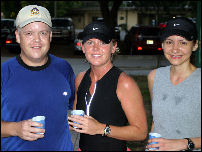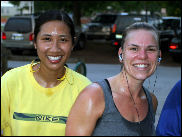Beginning Running 101 By Susan S. Paul, MS, TSF Training Program Director

It is time for you to begin an exercise program: the weather is cooling off, the kids are back in school, and vacations are over. Running, or walking, is one of the simplest and least expensive ways to improve your health and fitness. However, there are a few things that you should know before your begin your new exercise program that will help ensure your success.
Get Ready……………
Check with your Doctor- Any time you begin a new exercise program experts agree that you should see your family physician first. Inform your doctor as to the details of your plan and ask for his/her assessment. State your immediate or short-term goals: Are you trying to lose weight? Do you have any existing medical conditions that could be aggravated by your exercise plan? Are you taking any medications that could affect your exercise? Do you have any old injuries that could put you at higher risk for a running injury? State your long-term goals: Do you plan to run a 5k? Are you considering a marathon or a triathlon in the future? Discussing all these details and seeking any advice from your family physician will reduce your risk of injury and add to your success.
Safety first!
Plan your running or walking route carefully. Drive the course first to mark distances; such as the ½ mile and 1 mile mark. What time of day will you be exercising? Is the route well –lit? How much traffic is there? Are there sidewalks or bike lanes? Is there a water fountain along the way? Stay away from woodsy areas! Plan on carrying a cell phone, mace, and/or recruit your dog to accompany you. Women are especially at risk! Do NOT run with headphones!! Wearing headphones makes you an ideal target for would-be attackers!
Get Set…………….
Training partners and programs
A training partner can be invaluable. However, they must have similar goals and be of a similar pace. Training partners should become a support system for each other. Knowing that you are meeting someone for your daily run or walk helps motivate you to get out of bed when your resolve begins to lag. Another option is to check out local group training programs in your area like WRAP through the Track Shack Foundation. Group training programs offer coaching, supervision, group support, and camaraderie at reasonable prices.

You have survived your physical, gotten the thumbs up from your physician, mapped out a half-mile route through your neighborhood, and your best friend has decided to join you in your fitness quest. Now what? Your next stop should be a specialty running store equipped with professionals that can assess your foot and your needs and fit you in the proper shoe. DO NOT haul your old Keds out of the closet! The right gear and shoes are worth every penny! Check out the running clothing while you are there! While this clothing is not essential, new high-tech fabrics make exercising in Florida heat more comfortable. Some of these fabrics help reduce or eliminate chafing and blisters, wick away sweat, and dry quickly.
Go!....................
Training Plan
How far, how fast, how long should I go? First of all, start at the beginning. If you are 40 years old or older and/or have never exercised regularly, begin at the beginning by WALKING. Running puts an enormous amount of stress on joints, ligaments, muscles, bones, and tendons. Some stress makes us stronger; too much stress can lead to injuries. Beginning with a Walking Program allows your body time to adapt to your new fitness regime without too much stress; thus, reducing your risk of injury.
Distance vs. Time
You can schedule either a set amount of time or an allotted distance that realistically fits into your daily routine. Remember that it is better to start with very small increments and increase gradually. The recommended beginning time frame is 15-30 minutes; the recommended beginning distance is ½ mile to 1 mile.
Exercise Intensity
Keep your pace at a conversational level. This means you should be able to carry on a conversation with your training partner while you are walking or running. You should NOT be huffing and puffing and wondering how you are going to make it back home! On the other hand, you should be exercising hard enough that you cannot sing.
Frequency
The American College of Sports Medicine (ACSM) recommends exercising 3-4 times per week, or every other day. Beginning your exercise program following the every other day plan allows your body to recover between exercise sessions and reduces your risk of injury. As you adapt to exercise, you can increase either the time OR the distance of your training sessions. Adaptations generally occur within a 6-8 week time frame. Learn to listen to your body! If the exercise feels easy, then it is easy and it may be time to increase the time, the distance, or the intensity. If the exercise feels hard, then it is hard. Give yourself more time to adapt before changing the routine. If you feel tired or stressed you may be doing too much, too soon. Listen to your body and ease up a bit.
If you are a numbers person, you may like the “10% Rule”. When any given level of exercise becomes “easy” and you feel that it is time to increase your training level, increase your weekly time OR your weekly distance by 10%. Do NOT increase both! If you have been walking or running 6 miles a week (2 miles 3 times a week), then you would increase your mileage by 6/10ths of a mile the next week. If you have been exercising for 90 minutes a week (30 minutes 3 times a week), then you would increase your time by 9 minutes per week.
Transitioning from walking to running
When you feel your body has adapted to the stresses of walking and you are ready to take on some running, begin by mixing small increments of running in with your walking. Begin with your normal walk pace, allow yourself to warm-up, and then try a few minutes of jogging or running followed by walking. You can repeat this walk/run sequence as many times as you feel comfortable. Again applying the 10% rule, you can gradually add longer and longer running intervals until you are running the entire time or distance, if that is your desired goal.
Sample Training Program
|
Week 1 and Week 2: |
Use Facebook to Leave a Comment - We'd love to hear from you.







